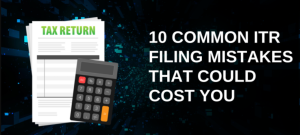Why Accurate ITR Filing Matters
Every year, millions of Indians file their Income Tax Returns (ITR). While most focus on getting refunds or meeting the deadline, many unknowingly make mistakes that can trigger scrutiny from the Income Tax Department (ITD).
With the rise of AIS (Annual Information Statement) and TIS (Taxpayer Information Summary), the ITD now has better visibility than ever into your financial life. A mismatch between your return and government records can lead to notices, refund delays, or even scrutiny under Sections 139(9), 143(1), or 143(2).

In this blog, we break down the top 10 mistakes that commonly lead to trouble — and how you can avoid them.
1. Mismatch with Form 26AS or AIS
The Problem:
Your ITR filing must match the income and TDS details reported in Form 26AS and AIS.
What Can Happen:
- Mismatch notice under Section 139(9)
- Refund delay
- Increased scrutiny under Section 143(1)
Fix:
Always download and verify your Form 26AS and AIS before filing.
2. Ignoring High-Value Transactions
Examples:
- Property purchase above ₹30 lakh
- Credit card bill above ₹10 lakh/year
- Large mutual fund purchases or withdrawals
These transactions are reported to the ITD by banks, registrars, and brokers.
What Can Happen:
If your declared income doesn’t justify these transactions, it raises red flags.
Fix:
Declare all sources of income and provide accurate capital gains details in ITR filing
3. Claiming Fake or Excessive Deductions
Most misused sections:
- Section 80C (LIC, PPF, ELSS)
- Section 80D (health insurance)
- Section 24(b) (home loan interest)
What Can Happen:
Mismatch with employer Form 16 or bank records could lead to rejection or scrutiny.
Fix:
Only claim deductions backed by valid proofs and receipts in ITR Filing
4. Reporting Business Losses or NIL Income Every Year
Consistently showing losses without clear business rationale may be flagged post itr filing
What Can Happen:
Scrutiny under Section 143(2) for income misreporting or bogus expenses.
Fix:
Maintain books of accounts and audit reports if applicable.
5. Not Disclosing Foreign Income or Assets
Especially important for NRIs, Indian residents with foreign bank accounts, stocks, or real estate.
What Can Happen:
- Penalty under Black Money Act
- Criminal prosecution in extreme cases
Fix:
Disclose foreign assets in Schedule FA if applicable.
6. TDS Mismatch or Overclaiming Tax Credit
Claiming more TDS than what’s in 26AS or AIS often leads to system-based rejections.
What Can Happen:
- Refund denied or adjusted
- Notice to reconcile TDS
Fix:
Match every TDS entry with Form 26AS and AIS during itr filing
7. Filing ITR Very Late or Skipping It Altogether
ITD now uses data from PAN, Aadhaar, bank accounts, and investments to track non-filers.
What Can Happen:
- Notices for non-filing
- Penalties under Section 234F (₹5,000 fine)
- Interest on unpaid tax (Sections 234A/B/C)
Fix:
File before the due date and avoid waiting until the last minute.
8. Failing to Validate Bank Account for Refund
Many refunds fail because taxpayers forget to validate their bank account on the e-filing portal.
What Can Happen:
- Refund status shows “Failed” or “Not Credited”
- Manual reprocessing required
Fix:
Use pre-validated bank accounts for refunds and verify them with correct IFSC/MICR.
9. Wrong ITR Form Selection
Filing ITR-1 when you’re eligible only for ITR-2 or ITR-3 can result in a defective return.
What Can Happen:
Notice under Section 139(9) and requirement to re-file.
Fix:
Use the ITR form best suited to your income type — e.g., ITR-2 for capital gains, ITR-3 for business income.
10. Incomplete Disclosure of Other Income
This includes:
- Freelance income
- Interest on savings accounts or FDs
- Rental income
- Crypto gains (if taxable)
What Can Happen:
Undisclosed income can invite penalty or scrutiny.
Fix:
Cross-check with AIS, bank passbooks, and digital wallets before itr filing.
Final Thoughts: Accuracy is Your Best Shield
Filing ITR isn’t a checkbox activity — it’s a legal declaration of your income. With advanced data tracking, AI-based scrutiny, and deep integration between PAN, Aadhaar, and financial systems, it’s easier than ever for the ITD to detect mismatches.
Takeaway: Always cross-check your data, use the correct form, and don’t underestimate the power of AIS and Form 26AS.
Bonus Tip: Tools to Use Before Filing
- Form 26AS portal
- AIS viewer on incometax.gov.in
- CA-assisted filing (for business or capital gains)
- Excel/PDF checklists to verify deductions and TDS
Open Demat account using:



